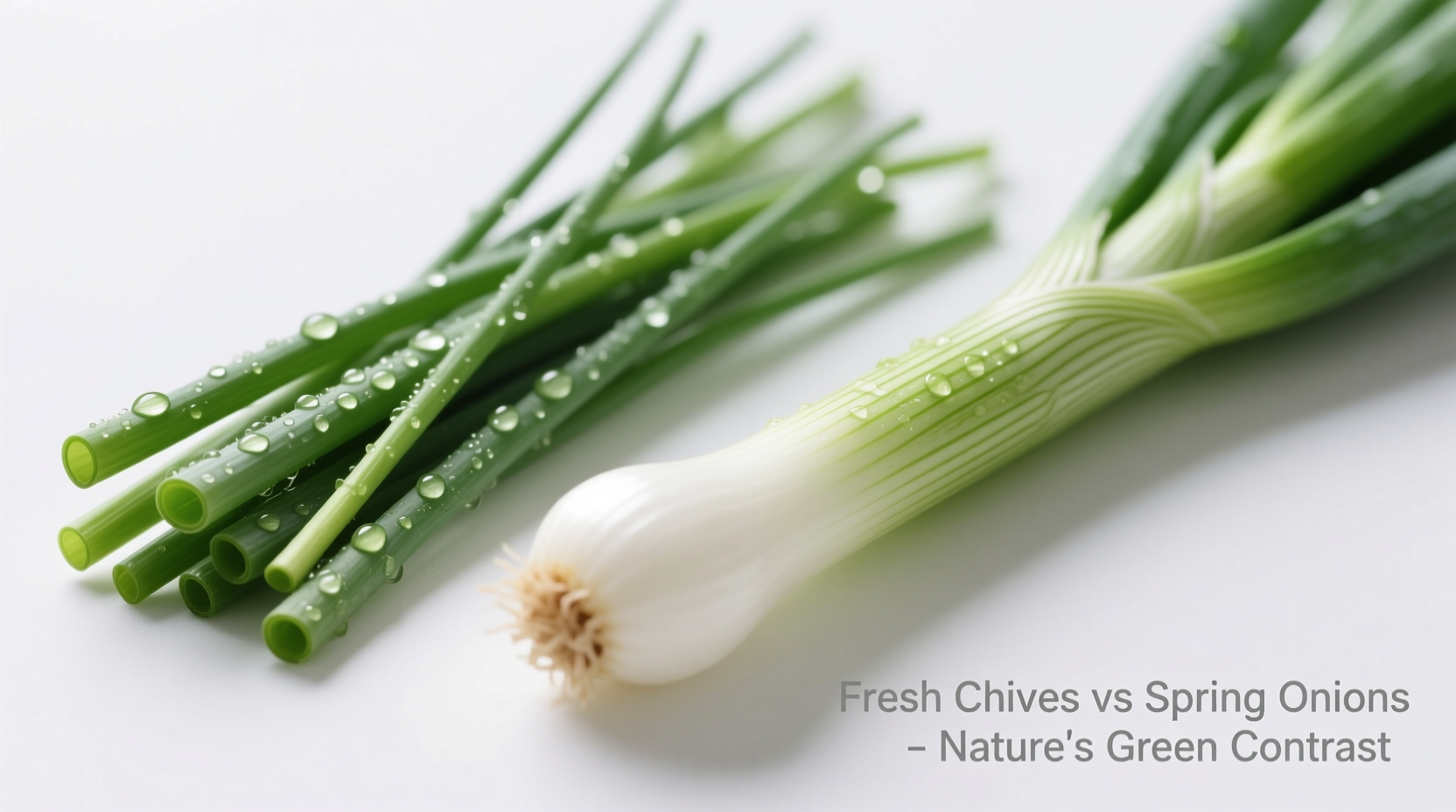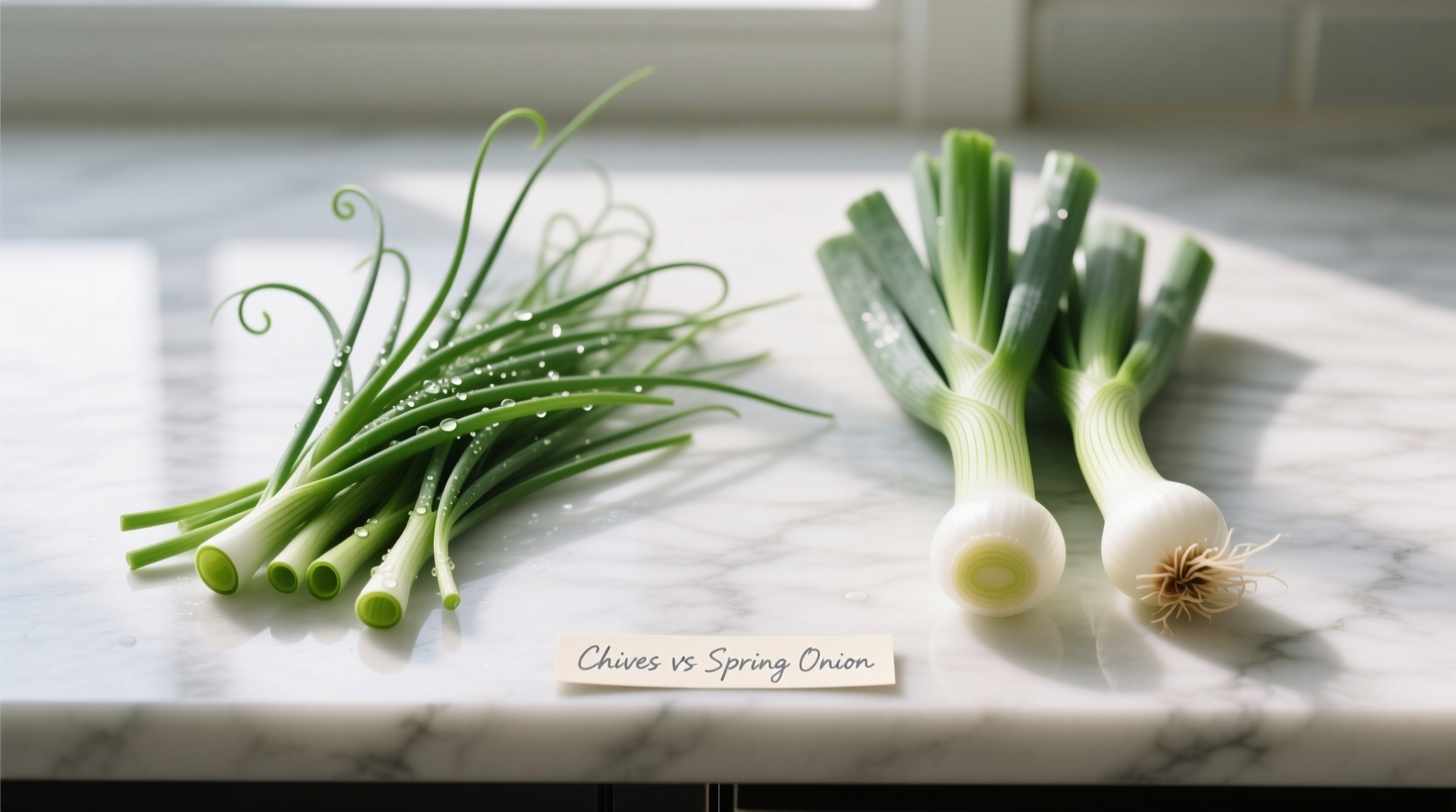Understanding the Fundamental Differences
When you're standing in the produce section trying to decide between chives and spring onions, knowing exactly what sets them apart can transform your cooking. These two allium varieties often cause confusion, but their botanical classifications, flavor profiles, and culinary applications differ significantly.
Visual Identification Guide
Telling these ingredients apart at first glance is crucial for recipe success. Chives appear as uniform, thin, hollow green tubes without any bulb formation. Spring onions, however, feature a distinct small white bulb at the base with thicker green stalks that aren't completely hollow.
| Characteristic | Chives | Spring Onions |
|---|---|---|
| Botanical Name | Allium schoenoprasum | Allium cepa var. aggregatum |
| Stem Structure | Fully hollow, uniform diameter | Solid lower portion, hollow upper portion |
| Bulb Development | No bulb formation | Small, round white bulb |
| Flavor Intensity | Mild, delicate onion flavor | Stronger, more pungent onion taste |
| Primary Culinary Use | Garnish, finishing touch | Cooking ingredient, flavor base |

Flavor Profiles and Culinary Applications
Understanding how these ingredients behave in cooking separates novice cooks from knowledgeable ones. Chives deliver a subtle onion essence that disappears when exposed to high heat, making them perfect for adding at the very end of cooking or as a fresh garnish. Professional chefs consistently add chives to dishes after removing from heat to preserve their delicate flavor compounds.
Spring onions, with their more robust flavor profile, withstand cooking beautifully. The white bulb portion provides a stronger base flavor similar to regular onions but milder, while the green tops offer a gentler onion note. According to culinary research from the Culinary Institute of America, spring onions contain higher concentrations of allyl sulfides—the compounds responsible for onion's characteristic flavor—than chives, explaining their more pronounced taste.
When to Use Each Ingredient
Choosing between chives and spring onions depends on your recipe's requirements and desired flavor impact:
- Reach for chives when: You want a subtle onion note without overpowering other ingredients, need a colorful garnish, or are finishing egg dishes, baked potatoes, or creamy soups
- Choose spring onions when: Building flavor foundations for stir-fries, roasting vegetables, grilling, or creating dishes where onion flavor should be prominent
Substitution Guidance You Can Trust
While substitutions aren't perfect, understanding the limitations helps prevent recipe disasters. If substituting spring onions for chives, use only the green tops and reduce quantity by half to avoid overwhelming your dish. When replacing spring onions with chives, increase the amount significantly and consider adding a small amount of minced shallot to compensate for the missing bulb flavor.
Food science research from the University of California Cooperative Extension confirms that chives contain different volatile compounds than spring onions, which explains why substitutions alter a dish's flavor profile. Chives feature higher concentrations of methyl allyl disulfide, creating their distinctive mild aroma, while spring onions contain more propyl disulfide, contributing to their stronger bite.
Nutritional Comparison
Both ingredients offer health benefits, but their nutritional profiles differ. According to USDA FoodData Central, spring onions provide significantly more vitamin C (18.8mg per 100g) compared to chives (27.7mg per 100g), while chives contain higher concentrations of vitamin K (212.7µg per 100g versus 20.6µg). Both are excellent sources of antioxidants and contain compounds associated with cardiovascular health.
Avoiding Common Mistakes
Even experienced home cooks make these errors when working with these alliums:
- Overcooking chives: Their delicate flavor vanishes with prolonged heat exposure
- Using entire spring onions interchangeably: The white and green parts have different cooking times and flavor intensities
- Improper storage: Chives last only 3-4 days refrigerated while spring onions can last 2-3 weeks when stored properly
- Confusing with scallions: Spring onions and scallions are often mistaken for each other, but scallions are harvested earlier with even smaller bulbs
Practical Cooking Tips
Maximize flavor from both ingredients with these professional techniques:
- Chop chives with scissors rather than a knife to prevent bruising and flavor loss
- Soak spring onions in ice water for 15 minutes before using to reduce sharpness
- When roasting spring onions, leave roots intact to prevent separation during cooking
- Freeze chopped chives in olive oil for longer storage while preserving flavor
Seasonal Availability and Selection
Chives are available year-round but peak in spring and early summer. Look for vibrant green, firm stems without yellowing. Spring onions have a longer season from late winter through summer. Choose those with crisp greens, firm white bulbs, and no signs of sprouting. According to agricultural data from the USDA National Agricultural Statistics Service, spring onion production has increased by 23% over the past decade as consumer awareness of their culinary versatility grows.











 浙公网安备
33010002000092号
浙公网安备
33010002000092号 浙B2-20120091-4
浙B2-20120091-4